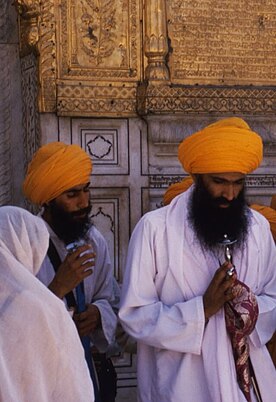
The Sarbat Khalsa of 1986 was one congregation of the Guru Khalsa Panth, including the Damdami Taksal, Akal Takht, Panthic Committee (Manochahal), Panthic Committee (Zaffarwal), Kharku Sikhs, Tarna Dal (Hariabelan), Tarna Dal (Baba Bakala), Bidhi Chand Dal and the Shiromani Budha Dal.[1][additional citation(s) needed]
Events[edit]
The Sarbat Khalsa was declared on 16 January 1986 by the Damdami Taksal and the Kharku organizations.[2] On 19 January, Surjit Singh Barnala's Barnala Jatha along with the Punjab Police attacked the Golden Temple, and 200 shots were fired in the complex towards them and away from them.[3] Afterwards far more support had arrived for the Sarbat Khalsa, they occupied the offices of the Damdami Taksal.[citation needed] On 20 January they were expelled by the Kharkus at gunpoint.[4] The Sarbat Khalsa's official date was 13 April 1986, on Vaisakhi.[citation needed]
The Sarbat Khalsa was hosted by the Panj Pyare who went as the Panthic Committee. They were Jathedar Gurdev Singh Kaunke, Baba Gurbachan Singh Manochahal, Karnail Dhanna Singh, Jarnail Aroor Singh and Jarnail Wassan Singh Zaffarwal.[5] During the Sarbat Khalsa an official declaration of Khalistan was made and the War for Khalistan against the Indian and Pakistani Governments was announced to the congregation of 600,000 Sikh.[6] Further an official army to fight for Khalistan was created. It was the Khalistan Commando Force.[7] The dissolution of the SGPC was also announced.[8]
The Shiromani Akali Dal held a Sarbat Khalsa in Anandpur Sahib in protest to the Sarbat Khalsa in Amritsar and the Mahimanas (guests) included Bibi Bimal Kaur Khalsa, Sant Thakur Singh Bhindranwale and Simranjit Singh Mann.[9] After the Panj Pyare and the Mahimanas met and devised a plan for the betterment of the Guru Khalsa Panth and Sikh Qaum, all their Gurmattas were announced on loudspeaker to the entire congregation by Baba Gurbachan Singh Manochahal.[citation needed] Generally all Sikhs wore Kesri turbans; the color of violent youth and Kharku Culture along with long Kirpans along with a few guns and other weapons.[10][unreliable source?]
After the Gurmata came of the declaration of the Khalistan Liberation War and the Khalistan Confederacy the entire GurSangat was made to oblige to them, they gave Jaikaras and raised their swords and guns in the air in celebration.[11] Multiple new war cries also came up such as "Bhindranwale Sant Sipahi, Sarkar ko kare Jhatkai" and "Beant Satwant Zindabad".[12] They also declared the Tankhaiya of Jathedar Santa Singh Nihang, and Jathedar Amrik Singh Nihang was made the new Jathedar of the Budha Dal.[13] Jathedar Kirpal Singh was also boycotted from the Akal Takht.[14] There was also a formation of four Panthic Committees, the Panthic Committee (Manochahal), Dooja Panthic Committee, Panthic Committee (Zaffarwal) and Panthic Committee (Babbar). They also declared rebuilding of the Akal Takht and destroyed the earlier structure, due to the earlier one being done by the Indian Government and was known as the 'Sarkar Takht'. Behind the Akal Takht the Sikhs did a 22 gun salute, one more than the President's gun salute, to show their dominance over India.[15][16][17]
After the Sarbat Khalsa, Operation Search was conducted on the 30 April 1986, they found no militants and one policeman was killed. They were only able to find one .12 bore shotgun and two Mausers.[18]
References[edit]
- ^ Sandhu, Amandeep. "Subverting A Popular Movement: How The Sarbat Khalsa Was Hijacked By Radical Sikh Bodies". The Caravan. Retrieved 8 June 2023.
- ^ "Sarbat Khalsa has many similarities with Sikhs' congregation held in January 1986". The Times of India. 11 November 2015. ISSN 0971-8257. Retrieved 8 June 2023.
- ^ "Sarbat Khalsa: An 18th-century strategic Sikh plenary". India Today. Retrieved 8 June 2023.
- ^ Bureau, Sikh Siyasat (14 December 2015). "Resolutions of the Sarbat Khalsa 1986 [Copy of the Resolutions]". Sikh Siyasat News. Retrieved 8 June 2023.
- ^ "SAD core committee rejects radical Sarbat Khalsa resolutions". Hindustan Times. 12 November 2015. Retrieved 8 June 2023.
- ^ Sandhu, Kanwar (16 November 2015). "In Nov 10 Sarbat Khalsa, Angry Voices From the Past Echo in Punjab". TheQuint. Retrieved 8 June 2023.
- ^ Punjab, Committee for Coordination on Disappearances in (2003). Reduced to Ashes: The Insurgency and Human Rights in Punjab : Final Report. Sikh Students Federation. p. 47. ISBN 978-99933-53-57-7.
- ^ Chima, Jugdep S. (24 March 2015). Ethnic Subnationalist Insurgencies in South Asia: Identities, Interests and Challenges to State Authority. Routledge. ISBN 978-1-317-55705-0.
- ^ "Aftermath of the Sarbat Khalsa: What the crisis in Punjab means for SAD". The Indian Express. 13 November 2015. Retrieved 8 June 2023.
- ^ "Timeline of incidents in Punjab (Jan to Dec 1986) | KEM". Khalistan Extremism Monitor. Retrieved 8 June 2023.
- ^ Chima, Jugdep S. (11 March 2010). The Sikh Separatist Insurgency in India: Political Leadership and Ethnonationalist Movements. SAGE Publishing India. ISBN 978-93-5150-953-0.
- ^ Malcolm, John (1812). Sketch of the Sikhs: A Singular Nation, who Inhabit the Provinces of the Penjab, Situated Between the Rivers Jumna and Indus. J. Murray.
- ^ Mandair, Arvind-Pal Singh (27 October 2017). Sikhism. Springer Netherlands. ISBN 978-94-024-0845-4.
- ^ Singh, Gurharpal; Shani, Giorgio (25 November 2021). Sikh Nationalism. Cambridge University Press. ISBN 978-1-009-21344-8.
- ^ Mansukhani, Gobind Singh (1993). Introduction to Sikhism. Hemkunt Press. ISBN 978-81-7010-181-9.
- ^ Punjab, Committee for Coordination on Disappearances in (2003). Reduced to Ashes: The Insurgency and Human Rights in Punjab : Final Report. Sikh Students Federation. ISBN 978-99933-53-57-7.
- ^ Kaur, Kuldeep (1999). Akali Dal in Punjab Politics: Splits and Mergers. Deep & Deep Publications. ISBN 978-81-7629-128-6.
- ^ Singh, Pashaura (26 August 2021). Exploring Sikh Traditions and Heritage. MDPI AG. ISBN 978-3-0365-1783-4.